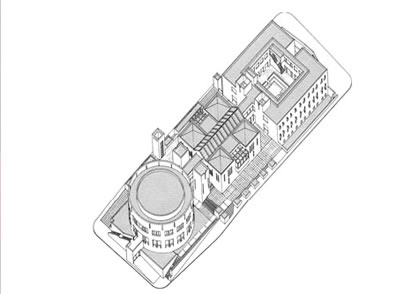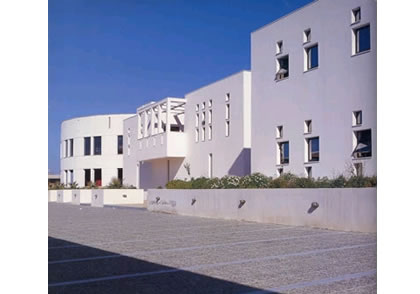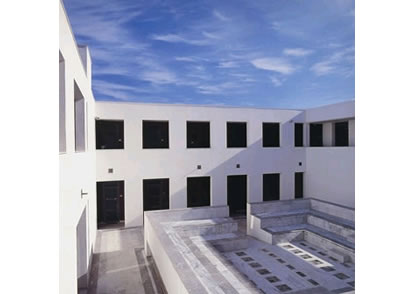 |
Research Centre Of Crete and University Of Crete
Heraklion 1985-90
The siting and organisation
of the complex have been determined by its proximity to the first building
of the university and by its mediating role with regard to future expansion.
The first building, a prefabricated system-like
structure, addressed only the urgent space needs of the newly formed
university. No attempt was made to create a 'place' or even to anticipate
growth. This original nucleus will therefore play only a secondary role
vis-à-vis the Research Centre.
The new campus is situated on the outskirts
of the city of Heraklion, approximately one mile from the ancient palace
of Knossos. Although Knossos is not visible from the site, its presence
as a point of reference was established by combing three buildings in
a sequential manner along the axis that connects it with the Venetian
port and Athens.
The organisational concept evolved from the
need to create a 'civic place' in an otherwise physically disorganised
and visually chaotic environment. The strong formal resolution of the
complex is intended to set up the process of a more orderly urbanisation
not only of the nucleus of the university, but of the area as a whole.
The Research Centre can be read both as one
building and as a cluster of independent buildings with an urban-like
intensity. It represents a threshold to any future expansion on the
eastern boundary of the site.
The courtyard building has offices for professors
and researchers on two levels and laboratories in the basement. The
cluster-galleria building contains computer facilities on the ground
floor and administrative offices above. The rotunda building has seminar
and meeting rooms on the ground floor and a library above.
The Heraklion Museum has on display some tiny
plaques portraying 'Minoan residential fenestration'. This has been
reinterpreted and woven into the elevations of the courtyard building.
The formal aspects of the buildings refer to or synthesise Greek and
Italian paradigms of building types and materials. In many ways the organisation
of the complex evokes the memory of The Renaissance, which Greece never
had.
The complex was designed initially for the
Research Centre of Crete and completed by the University of Crete, now
part of FORTH (Foundation of Research and Technology. Hellas). The project
was undertaken in association with the Technical Office of the University
of Crete.
Collaborators
: Alek Zarifian. A Lukaitou.
Model: William Lippens
Below
: Axonometric
|
 |


